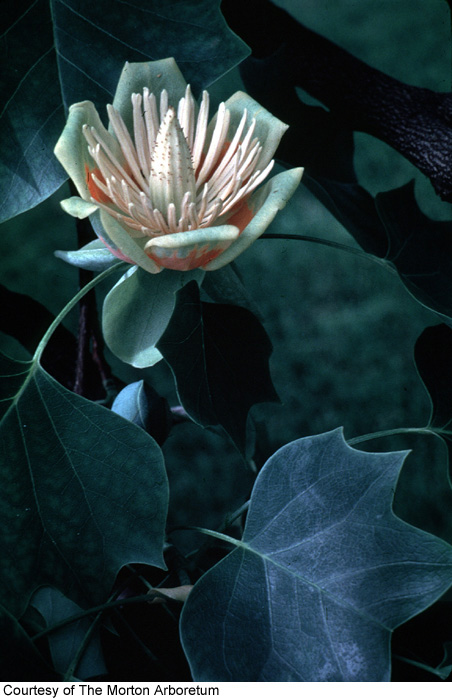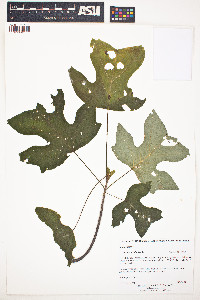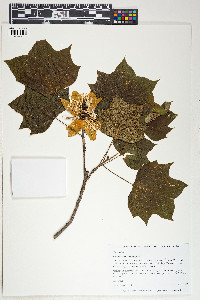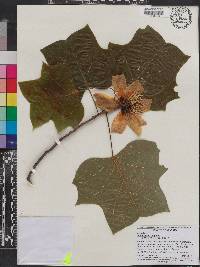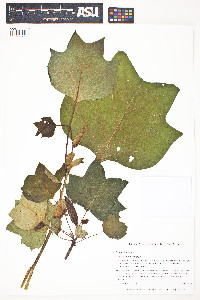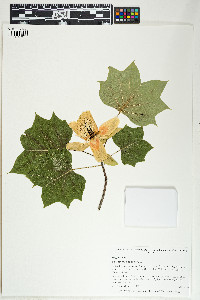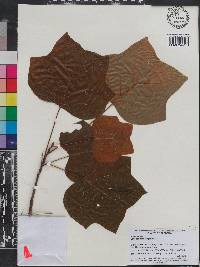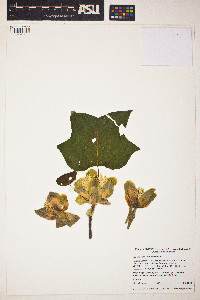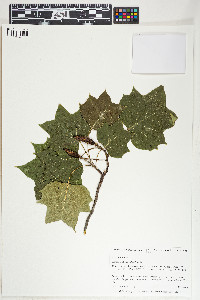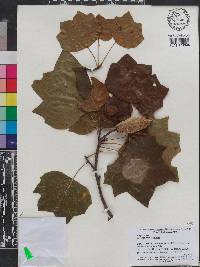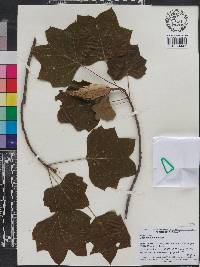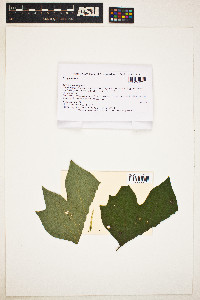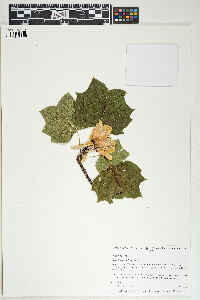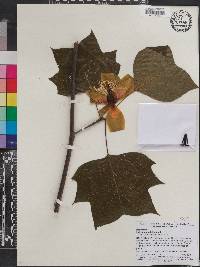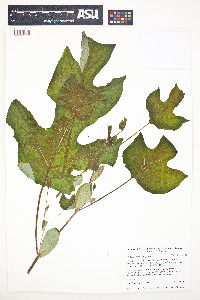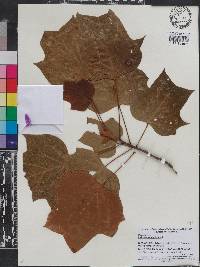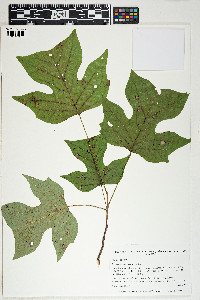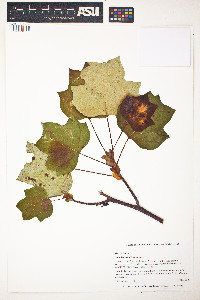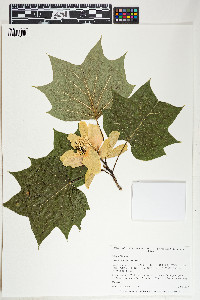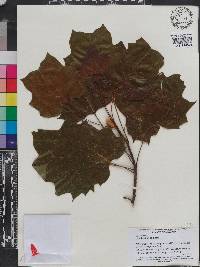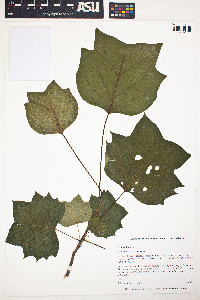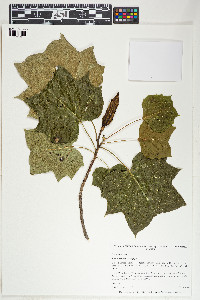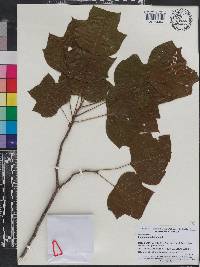- Home
- Search
- Images
- Datasets
- Sample Use
- How to Cite
- Additional Information
- About NEON
- NEON Data Portal
- ASU Biocollections
- About Symbiota
|
|
|
|
Family: Magnoliaceae
tuliptree
|
Trees , single-trunked, to 45 m. Bark light gray, thick, deeply furrowed. Stipules paired, light green, elliptic to oblanceolate, 20-45mm; petiole 5-11.5 cm. Leaf blade commonly with 2 shallow upper lobes and 2 lateral lobes at broadest part, or sometimes squarrose and barely lobed, (6.5-)7.5-15(-23.5) × (8.5-)12.5-18.5(-25.5) cm; surfaces abaxially glaucous, adaxially bright green. Flowers campanulate; spathaceous bract 1, brownish, notched; tepals erect, adaxial orange blotch sometimes gummy, outermost tepals green to glaucous; stamens 20-50, 40-50 mm; filaments white; pistils 60-100. Samaracetums 4.5-8.5 cm, with numerous (1-)2-seeded, imbricate samaras 3-5.5 × 0.5-1 cm, falling separately at maturity; receptacles with basal pistil persistent. Seeds (1-)2. 2 n =38. Flowering spring. Rich woodlands, bluffs, low mountains, and hills; 0-1500 m; Ont.; Ala., Ark., Conn., Del., D.C., Fla., Ga., Ill., Ind., Ky., La., Md., Mass., Mich., Miss., Mo., N.J., N.Y., N.C., Ohio, Pa., R.I., S.C., Tenn., Vt., Va., W.Va. Leaf and flower color variation are widespread in this species, but the variation is continuous and without any discernible taxonomic significance. Liriodendron tulipifera is widely cultivated; a few cultivars have been introduced to horticulture, and the hybrid L. tulipifera × L. chinense is known. Liriodendron tulipifera is reported to have escaped from cultivation in Texas, but I have seen no specimens. The specimens from Barry and Ozark counties, Missouri, may not be indigenous. Liriodendron tulipifera is the state tree of both Indiana and Tennessee. Native American tribes used Liriodendron tulipifera for making canoes. Cherokee and Rappahannock tribes used bark of the roots as a bitter tonic and heart stimulant, and it was considered useful in healing fevers, rheumatism, and digestive disorders (D. E. Moerman 1986). The largest known tree of Liriodendron tulipifera , 44.5 m in height with a trunk diameter of 3.02 m, is recorded from Bedford, Virginia (American Forestry Association 1994).
Tree 18 - 32 m tall, trunk 0.6 - 1.2 m in diameter Leaves: alternate, bright green above, paler beneath, 8 - 15 cm long and wide, shaped like a cat's face, usually having four large lobes, occasionally with a few smaller lobes near the base, notched at the tip, non-toothed. Leaves turn yellow in fall. Flowers: usually at ends of branches near the top of the tree, greenish yellow with an orange blotch near the center, tulip-shaped, six-petaled, with many stamens and pistils. Fruit: a cone-like aggregate of winged seeds (samaras), 5 - 8 cm long, green changing to light brown, narrow, elongated. The stalk and axis of the fruit persisting after the samaras mature and disperse. Bark: greenish gray and scaly when young, becoming brownish gray and deeply furrowed with interlacing rounded ridges. Twigs: changing from reddish to brown to gray, shiny, smooth, encircled by stipular scars, citrus-scented when crushed. Terminal buds: 1.3 - 2 cm long, short-stalked, flattened, resembling a duck's beak, green to reddish brown, covered with a waxy coating (glaucous), with two scales that do not overlap (valvate). Similar species: Liriodendron tulipifera is easy to distinguish in the Chicago Region. It has four-lobed leaves with notched tips, flattened terminal buds that resemble duck beaks, stipular scars that encircle the citrus-scented twigs, tulip-shaped flowers, and cone-like clusters of winged fruit. Flowering: mid May to mid July Habitat and ecology: Common in the eastern Chicago Region in open areas of woodlands, L. tulipifera is also found on stable dune slopes. Spontaneously occurring plants found in Illinois have probably escaped from cultivation since Michigan and Indiana are at the northwestern edge of the species' native range. Occurence in the Chicago region: native Notes: This species is commonly used in landscaping, especially in large yards and parks. The wood is used in making furniture, veneer, crates, and pulpwood. This is the state tree of Indiana. Etymology: Liriodendron comes from the Greek words leirion, meaning a lily, and dendron, meaning a tree. Tulipifera means tulip-bearing, referring to the resemblance of the flower to a tulip. Author: The Morton Arboretum Sturdy tree to 60 m; lvs long-petioled, 8-14 cm long and about as wide, broadly retuse; fls solitary at the ends of the branches; sep pale green; pet 4-5 cm, greenish-yellow, with a large basal orange blotch within; frs narrow and elongate, 3-4 cm; 2n=38. Rich woods; Vt. to s. Mich., s. Ill., and se. Mo., s. to Fla. and La., often cult. May, June. Gleason, Henry A. & Cronquist, Arthur J. 1991. Manual of vascular plants of northeastern United States and adjacent Canada. lxxv + 910 pp. ©The New York Botanical Garden. All rights reserved. Used by permission. |


